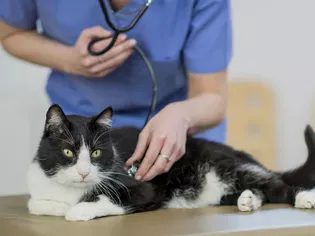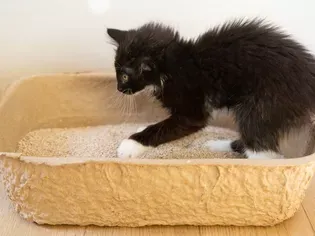Saddle Thrombus in Cats
Updated on 05/26/24

Saddle Thrombus in Cats: A Comprehensive Guide
Introduction
Saddle thrombus is a life-threatening condition in cats that occurs when a blood clot forms in the aorta, the main artery that carries blood away from the heart. This clot can block blood flow to the hind legs, tail, and bladder, leading to severe pain, paralysis, and even death.
Causes of Saddle Thrombus
The exact cause of saddle thrombus in cats is unknown, but several factors are thought to contribute, including:
* Heart disease: Cats with heart disease, particularly hypertrophic cardiomyopathy, are at increased risk of developing saddle thrombus.
* Blood clotting disorders: Cats with certain blood clotting disorders, such as hypercoagulability, are more likely to form blood clots.
* Trauma: Severe trauma can damage the aorta and increase the risk of clot formation.
* Diabetes mellitus: Diabetes can damage blood vessels and make cats more susceptible to clotting.
* Obesity: Obese cats have a higher risk of developing saddle thrombus due to increased inflammation and alterations in blood clotting factors.
Symptoms of Saddle Thrombus
The clinical signs of saddle thrombus in cats can vary depending on the severity of the clot. However, common symptoms include:
* Sudden hind leg paralysis: This is the most common symptom and can range from weakness to complete inability to walk.
* Tail paralysis: The tail may become weak or limp.
* Pain in the hind legs or tail: The cat may appear uncomfortable or cry out when touched in these areas.
* Cold or pale hind legs: The hind legs may feel cold or have a bluish tinge due to lack of blood flow.
* Difficulty urinating and defecating: The clot can block blood flow to the bladder and intestines, leading to difficulty urinating or defecating.
* Weakness and collapse: The cat may become weak and collapse due to the pain and lack of oxygen to the hindquarters.
Diagnosis of Saddle Thrombus
Diagnosing saddle thrombus requires a thorough physical examination and diagnostic tests. Your veterinarian will perform the following:
* Physical examination: Your veterinarian will assess the cat's hind legs, tail, and bladder for signs of paralysis, pain, or discoloration.
* Blood tests: Blood tests may reveal elevated levels of clotting factors or signs of inflammation.
* Chest X-rays: Chest X-rays can show an enlarged heart or other signs of heart disease.
* Ultrasound (echocardiography): Ultrasound can visualize the heart and aorta to identify any clots or abnormalities.
Treatment of Saddle Thrombus
Treatment for saddle thrombus is urgent and involves the following steps:
* Emergency stabilization: The cat will be given oxygen, pain medication, and fluids to support its vital functions.
* Anticoagulants: Anticoagulants are medications that prevent blood clots from forming or growing.
* Surgery: In severe cases, surgery may be necessary to remove the clot from the aorta.
* Physical therapy: After the clot has been treated, the cat may need physical therapy to regain function in its hind legs and tail.
Prognosis of Saddle Thrombus
The prognosis for saddle thrombus in cats is variable and depends on the severity of the clot and how quickly it is treated. With prompt and aggressive treatment, some cats can make a full recovery. However, others may have permanent paralysis or other complications.
Preventing Saddle Thrombus
There are no guaranteed ways to prevent saddle thrombus, but the following measures may help reduce the risk:
* Regular veterinary checkups: Regular veterinary exams can help identify and treat heart disease or other underlying conditions that increase the risk of saddle thrombus.
* Weight management: Obesity is a major risk factor for saddle thrombus, so it is important to maintain a healthy weight for your cat.
* Adequate hydration: Cats that are dehydrated are more likely to develop blood clots, so make sure your cat has access to plenty of fresh water.
* Avoidance of trauma: Severe trauma can damage the aorta and increase the risk of clot formation, so try to keep your cat safe from accidents.
Conclusion
Saddle thrombus is a serious but treatable condition in cats. Early diagnosis and aggressive treatment are crucial for improving the chances of a successful outcome. If you notice any signs of saddle thrombus in your cat, such as sudden hind leg paralysis, tail paralysis, or pain in the hind legs, seek veterinary attention immediately.
Explore More Pets

Cat Behavior Problems
How to Stop Aggression in Kittens

Long-Haired Cat Breeds
Siberian Cat: Breed Profile, Characteristics, & Care

Cat Behavior Problems
How to Stop Kittens From Scratching and Biting

Long-Haired Cat Breeds
Turkish Angora: Cat Breed Profile, Characteristics & Care

Basic Training
How to Socialize Your Kitten

Short-Haired Cat Breeds
Cute Pictures & Facts About Calico Cats & Kittens

Litter Box Training
Training Your Kitten to Use the Litter Box

Long-Haired Cat Breeds
10 Fun Facts About White Cats
